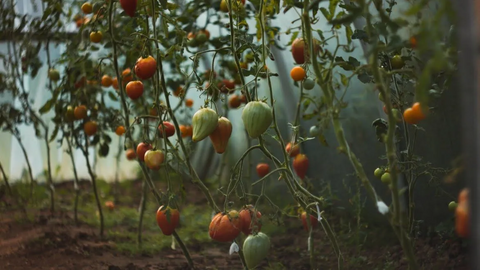Raised garden beds have become a popular choice for cultivating fruits, offering a tailored environment that promotes healthy growth and ease of maintenance. In this guide, we'll explore the top 10 fruits that not only flourish in raised beds but also benefit from the unique advantages this gardening approach provides. The following content also has some reference value for raised garden beds.
1. Strawberries: The Crown Jewel of Raised Beds
Why Strawberries?
Strawberries are a natural fit for raised beds due to their compact growth habit. Their shallow root system aligns perfectly with the depth of raised beds, making them easy to manage and harvest.
Benefits of Raised Beds:
- Improved Drainage: Raised beds provide excellent drainage, preventing waterlogged soil that can harm strawberry plants.
- Easy Access: The elevated height of raised beds makes it convenient to tend to strawberries without bending or kneeling.
2. Blueberries: Thriving in Acidic Comfort
Why Blueberries?
Blueberries thrive in acidic soil, and raised beds offer the advantage of tailoring the soil composition to meet their specific needs. Additionally, the controlled environment of raised beds allows for better pH regulation.
Benefits of Raised Beds:
- Acidic Soil Control: Easily adjust the soil pH to create the ideal acidic conditions for blueberry bushes.
- Better Aeration: Raised beds promote improved aeration, crucial for the shallow root system of blueberries.
3. Dwarf Fruit Trees: The Vertical Orchard
Why Dwarf Fruit Trees?
In limited space, dwarf fruit trees shine as they can be strategically planted in raised beds, providing the luxury of having a mini orchard on your doorstep.
Benefits of Raised Beds:
- Efficient Use of Space: Raised beds maximize space utilization, allowing for the cultivation of multiple dwarf fruit trees.
- Optimal Soil Depth: Dwarf fruit trees thrive in the well-draining soil of raised beds without the constraints of compacted ground.
4. Cucumbers: Reaching New Heights
Why Cucumbers?
Cucumbers, with their sprawling vines, find a perfect home in raised beds with the added benefit of vertical gardening. Trellises and supports can be easily integrated, maximizing both space and yield.
Benefits of Raised Beds:
- Vertical Growing: Utilize trellises for vertical growth, preventing overcrowding and promoting air circulation.
- Enhanced Pest Control: Raised beds make it easier to monitor and manage pests that might affect cucumber plants.
5. Tomatoes: Raised Beds, Elevated Flavor
Why Tomatoes?
Tomatoes thrive in the well-draining soil of raised beds, and the elevated height makes it easier to support their vines, resulting in healthier plants and more substantial harvests.
Benefits of Raised Beds:
- Improved Drainage: Raised beds prevent waterlogged soil, a common issue for tomatoes, promoting robust root development.
- Sturdy Support: Easily install stakes or cages for tomatoes, providing essential support for their growth.
6. Raspberries: Vertical Elegance in Raised Beds
Why Raspberries?
Raspberries, with their vertical canes, can be effectively grown in raised beds, allowing for organized and accessible harvesting.
Benefits of Raised Beds:
- Vertical Support: Raised beds make it easier to install trellises for raspberries, supporting their vertical growth.
- Ease of Harvest: The elevated height simplifies the process of picking ripe raspberries without unnecessary bending.
7. Apples: Dwarf Varieties for Compact Spaces
Why Apples?
Dwarf apple trees, suitable for raised beds, offer the joy of growing your own apples even in limited outdoor spaces.
Benefits of Raised Beds:
- Space Efficiency: Dwarf apple trees fit well within the confines of raised beds, maximizing available space.
- Customizable Soil: Tailor the soil conditions to suit the specific needs of apple trees, enhancing their overall health.
8. Peppers: Compact and Prolific
Why Peppers?
Pepper plants, especially compact varieties, thrive in the controlled environment of raised beds, producing abundant yields.
Benefits of Raised Beds:
- Optimized Growing Conditions: Raised beds allow for precise control over soil quality, ensuring peppers receive essential nutrients.
- Space Utilization: The compact nature of raised beds is ideal for planting multiple pepper varieties, enhancing diversity.
9. Blackberries: Controlled Growth in Raised Beds
Why Blackberries?
Blackberries, with their sprawling growth habit, benefit from the contained space of raised beds, preventing uncontrolled expansion.
Benefits of Raised Beds:
- Containment: Raised beds limit the spread of blackberry canes, preventing them from taking over the garden.
- Organized Planting: Easily organize and support blackberry canes within the confines of raised beds.
10. Cherries: Miniature Delights in Raised Beds
Why Cherries?
Dwarf cherry tree varieties flourish in raised beds, offering the delight of homegrown cherries in a confined space.
Benefits of Raised Beds:
- Space Optimization: Dwarf cherry trees can be strategically placed in raised beds, making the most of limited space.
- Improved Drainage: Raised beds prevent waterlogging, a potential issue for cherry trees, promoting healthier root systems.
Benefits of Growing Fruits in Raised Beds
Optimal Soil Control
- Raised beds allow precise control over soil composition, ensuring that fruits receive the specific nutrients they need for optimal growth and fruiting.
Improved Drainage
- The elevated design of raised beds prevents waterlogging, promoting healthier root systems and preventing diseases related to excess moisture.
Enhanced Aeration:
- Raised beds provide better aeration, preventing soil compaction and allowing roots to access oxygen more efficiently.
Easy Access and Maintenance:
- The raised height of beds eliminates the need for excessive bending or kneeling, making it more accessible for planting, tending, and harvesting.
Space Optimization:
- Raised beds maximize gardening space, enabling the cultivation of a variety of fruits even in limited areas, creating a mini orchard or berry patch.
Pest Management:
- The elevated structure of raised beds facilitates better pest monitoring and management, ensuring a healthier environment for fruit-bearing plants.
Conclusion
Selecting fruits for your raised garden beds involves considering not only the suitability of the plant but also the unique advantages that raised beds offer. Whether you're cultivating strawberries, blueberries, or dwarf fruit trees, the elevated gardening experience promises a fruitful and efficient harvest. Happy gardening!












